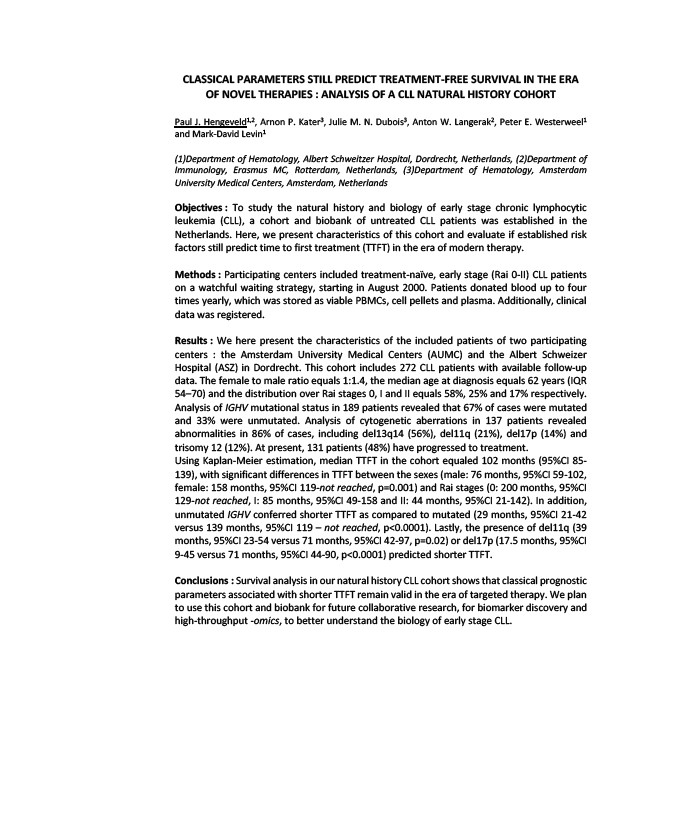
CLASSICAL PARAMETERS STILL PREDICT TREATMENT-FREE SURVIVAL IN THE ERA
OF NOVEL THERAPIES : ANALYSIS OF A CLL NATURAL HISTORY COHORT
Paul J. Hengeveld1,2, Arnon P. Kater3, Julie M. N. Dubois3, Anton W. Langerak2, Peter E. Westerweel1
and Mark-David Levin1
(1)Department of Hematology, Albert Schweitzer Hospital, Dordrecht, Netherlands, (2)Department of
Immunology, Erasmus MC, Rotterdam, Netherlands, (3)Department of Hematology, Amsterdam
University Medical Centers, Amsterdam, Netherlands
Objectives : To study the natural history and biology of early stage chronic lymphocytic
leukemia (CLL), a cohort and biobank of untreated CLL patients was established in the
Netherlands. Here, we present characteristics of this cohort and evaluate if established risk
factors still predict time to first treatment (TTFT) in the era of modern therapy.
Methods : Participating centers included treatment-naïve, early stage (Rai 0-II) CLL patients
on a watchful waiting strategy, starting in August 2000. Patients donated blood up to four
times yearly, which was stored as viable PBMCs, cell pellets and plasma. Additionally, clinical
data was registered.
Results : We here present the characteristics of the included patients of two participating
centers : the Amsterdam University Medical Centers (AUMC) and the Albert Schweizer
Hospital (ASZ) in Dordrecht. This cohort includes 272 CLL patients with available follow-up
data. The female to male ratio equals 1:1.4, the median age at diagnosis equals 62 years (IQR
54–70) and the distribution over Rai stages 0, I and II equals 58%, 25% and 17% respectively.
Analysis of IGHV mutational status in 189 patients revealed that 67% of cases were mutated
and 33% were unmutated. Analysis of cytogenetic aberrations in 137 patients revealed
abnormalities in 86% of cases, including del13q14 (56%), del11q (21%), del17p (14%) and
trisomy 12 (12%). At present, 131 patients (48%) have progressed to treatment.
Using Kaplan-Meier estimation, median TTFT in the cohort equaled 102 months (95%CI 85-
139), with significant differences in TTFT between the sexes (male: 76 months, 95%CI 59-102,
female: 158 months, 95%CI 119-not reached, p=0.001) and Rai stages (0: 200 months, 95%CI
129-not reached, I: 85 months, 95%CI 49-158 and II: 44 months, 95%CI 21-142). In addition,
unmutated IGHV conferred shorter TTFT as compared to mutated (29 months, 95%CI 21-42
versus 139 months, 95%CI 119 – not reached, p<0.0001). Lastly, the presence of del11q (39
months, 95%CI 23-54 versus 71 months, 95%CI 42-97, p=0.02) or del17p (17.5 months, 95%CI
9-45 versus 71 months, 95%CI 44-90, p<0.0001) predicted shorter TTFT.
Conclusions : Survival analysis in our natural history CLL cohort shows that classical prognostic
parameters associated with shorter TTFT remain valid in the era of targeted therapy. We plan
to use this cohort and biobank for future collaborative research, for biomarker discovery and
high-throughput -omics, to better understand the biology of early stage CLL.